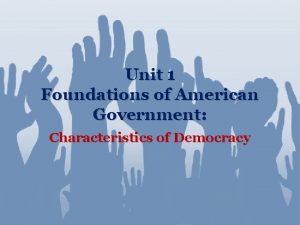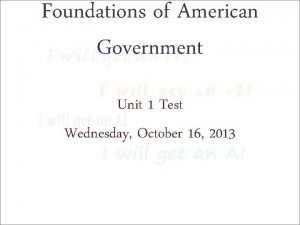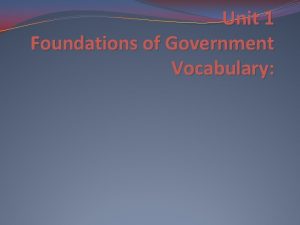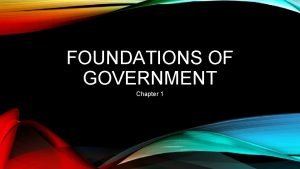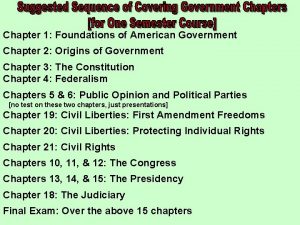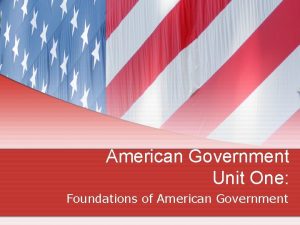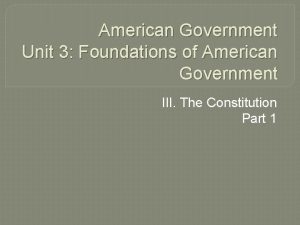UNIT 1 Foundations of American Government CHAPTER 1





- Slides: 5

UNIT 1 Foundations of American Government

CHAPTER 1. 1 FREE RESPONSE • The Equal Access Act of 1984 (EAA) states, “It shall be unlawful for any public secondary school which receives Federal financial assistance…to deny equal access or a fair opportunity to, or discriminate against, any students who wish to conduct a meeting…on the basis of the religious, political, philosophical, or other content of the speech at such meetings. ” A. Describe the purpose of the EAA. (1 point) • Institutions that are subject to EAA: public HS receiving federal funding • What those institutions must do: allow students to meet on school property without regard to the content of their speech B. Describe how Bridget Mergens and the Gay-Straight Alliance (GSA) at Boyd County HS used the EAA to assert their rights (1 point) • Both Mergens & the GSA each used the EAA to advance a minority view: religious observance for Ms. Mergens • tolerance of sexual differences for GSA C. Explain one way in which the efforts of Bridget Mergens and the GSA, and the actions of the officials at their schools, illustrate the tension between protecting liberty and establishing order. (1 point)

CHAPTER 1. 2: IDEALS OF DEMOCRACY • The U. S. Government is based on ideals of limited government: • Enlightenment Principles • Democracy: power is held by the people • Natural rights: the right to life, liberty, and property, which the government cannot take away • Social contract: Individuals consent to surrender some of their freedoms and submit to the authority of a rule in exchange for protection over their remaining rights. • Government by the People • Popular sovereignty: the idea that the government’s right to rule comes from the people • Republicanism: the authority of the government comes from the people

CHAPTER 1. 2: THE DECLARATION OF INDEPENDENCE • Declaration of Independence • Thomas Jefferson intentionally included natural rights as a main argument • Inalienable rights (life, liberty, pursuit of happiness) were denied • should be self-evident under the law of nature • Connection with Constitution • Individual became the central focus of government policy • Equality, freedom, and order – driving forces in our

CHAPTER 1. 2 FREE RESPONSE A. Identify the most common belief about the American dream shown in the bar chart. (1 point) • Anyone can succeed in America so long as they work hard enough. B. Describe difference of opinion shown in the bar chart, based on political ideology. (2 points) Ø Must refer to the chart & distinguish between Dems, and both Independents & Republicans on the other side. • Democrats: only 58%, less than Republicans and Independents believe that working hard enough will equal success • Independents and Republicans: 73% and 72% respectively believe that hard work will equal success. C. Explain one reason why it is difficult to measure beliefs about the American dream. (4 points) Ø explain how political ideology differs from one demographic group to another thus from one political group to another. • Political parties are composed of different demographic groups, with minorities tending to favor the Democratic Party. Members of those groups who have felt discrimination in the past see more difficulty in attaining the American dream than members of the majority ethnicities.
